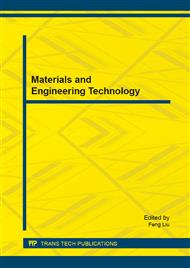p.96
p.102
p.106
p.110
p.114
p.119
p.123
p.127
p.132
Ionic Conduction Mechanism of Solid Biodegradable Polymer Electrolytes Based Carboxymethyl Cellulose Doped Ammonium Thiocyanate
Abstract:
A conducting solid biodegradable polymer electrolytes based carboxymethyl cellulose (CMC) doped ammonium thiocyanate (NH4SCN) system with concentration in the range 0 – 25 wt.% of NH4SCN have been prepared via solution casting method. The impedance study of CMC-NH4SCN system was measured via Electrical Impedance Spectroscopy (EIS) in the temperature range 303 K – 353 K. The highest ionic conductivity at room temperature (303 K) is 6.48 x 10-5 Scm-1 for sample containing 25 wt.% NH4SCN. The temperature dependence of CMC-NH4SCN system was found to obey the Arrhenius behaviour where the ionic conductivity increases with increase of temperature. Dielectric data were analyzed using complex permittivity, Ɛi for sample with the highest ionic conductivity at various temperatures and found was non Debye behavior. The conduction mechanism of the charge carrier of CMC-NH4SCN system can be presented by quantum mechanical tunneling (QMT) model.
Info:
Periodical:
Pages:
114-118
Citation:
Online since:
January 2015
Authors:
Price:
Сopyright:
© 2015 Trans Tech Publications Ltd. All Rights Reserved
Share:
Citation:


